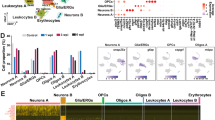Abstract
Due to their renowned regenerative capacity, adult zebrafish are a premier vertebrate model to interrogate mechanisms of innate spinal cord regeneration. Following complete transection to their spinal cord, zebrafish extend glial and axonal bridges across severed tissue, regenerate neurons proximal to the lesion, and regain swim capacity within 8 weeks of injury. Here, we describe methods to perform complete spinal cord transections and to assess functional and cellular recovery during regeneration. For spinal cord injury, a complete transection is performed 4 mm caudal to the brainstem. Swim endurance is quantified as a central readout of functional spinal cord repair. For swim endurance, zebrafish are subjected to a constantly increasing water current velocity until exhaustion, and time at exhaustion is reported. To assess cellular regeneration, histological examination is performed to analyze the extents of glial and axonal bridging across the lesion.
Access this chapter
Tax calculation will be finalised at checkout
Purchases are for personal use only
Similar content being viewed by others
References
Becker T, Wullimann MF, Becker CG, Bernhardt RR, Schachner M (1997) Axonal regrowth after spinal cord transection in adult zebrafish. J Comp Neurol 377(4):577
Becker CG, Becker T (2008) Adult zebrafish as a model for successful central nervous system regeneration. Restor Neurol Neurosci 26(2–3):71
Reimer MM, Sorensen I, Kuscha V, Frank RE, Liu C, Becker CG, Becker T (2008) Motor neuron regeneration in adult zebrafish. J Neurosci 28(34):8510
Goldshmit Y, Sztal TE, Jusuf PR, Hall TE, Nguyen-Chi M, Currie PD (2012) Fgf-dependent glial cell bridges facilitate spinal cord regeneration in zebrafish. J Neurosci 32(22):7477
Mokalled MH, Patra C, Dickson AL, Endo T, Stainier DY, Poss KD (2016) Injury-induced ctgfa directs glial bridging and spinal cord regeneration in zebrafish. Science 354(6312):630
Cavone L, McCann T, Drake LK, Aguzzi EA, Oprisoreanu AM, Pedersen E, Sandi S, Selvarajah J, Tsarouchas TM, Wehner D, Keatinge M, Mysiak KS, Henderson BEP, Dobie R, Henderson NC, Becker T, Becker CG (2021) A unique macrophage subpopulation signals directly to progenitor cells to promote regenerative neurogenesis in the zebrafish spinal cord. Dev Cell 56(11):1617
Klatt Shaw D, Saraswathy VM, Zhou L, McAdow AR, Burris B, Butka E, Morris SA, Dietmann S, Mokalled MH (2021) Localized EMT reprograms glial progenitors to promote spinal cord repair. Dev Cell 56(5):613
Burris B, Jensen N, Mokalled MH (2021) Assessment of swim endurance and swim behavior in Adult Zebrafish. J Vis Exp 177
Acknowledgments
This research was supported by grants from NIH (R01 NS113915), the Curators of the University of Missouri (Spinal Cord Injury and Disease Training Program), and funds from Washington University School of Medicine in St. Louis.
Author information
Authors and Affiliations
Corresponding author
Editor information
Editors and Affiliations
Rights and permissions
Copyright information
© 2024 The Author(s), under exclusive license to Springer Science+Business Media, LLC, part of Springer Nature
About this protocol
Cite this protocol
Burris, B., Mokalled, M.H. (2024). Spinal Cord Injury and Assays for Regeneration. In: Amatruda, J.F., Houart, C., Kawakami, K., Poss, K.D. (eds) Zebrafish. Methods in Molecular Biology, vol 2707. Humana, New York, NY. https://doi.org/10.1007/978-1-0716-3401-1_14
Download citation
DOI: https://doi.org/10.1007/978-1-0716-3401-1_14
Published:
Publisher Name: Humana, New York, NY
Print ISBN: 978-1-0716-3400-4
Online ISBN: 978-1-0716-3401-1
eBook Packages: Springer Protocols




